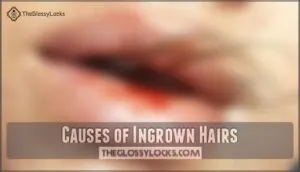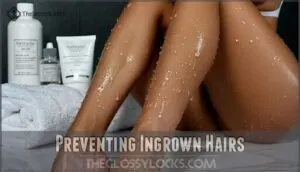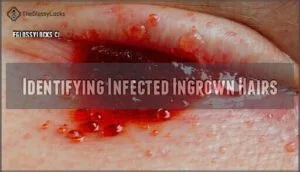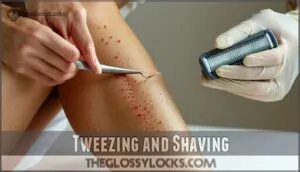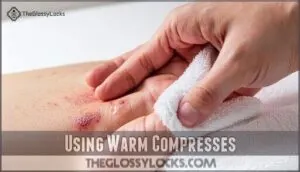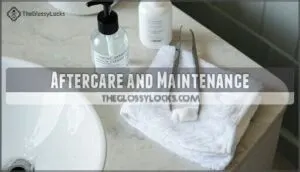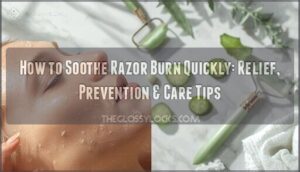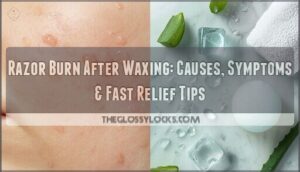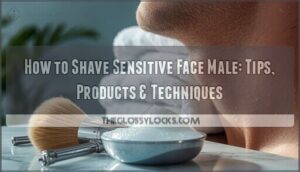This site is supported by our readers. We may earn a commission, at no cost to you, if you purchase through links.
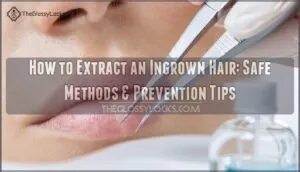
Clean sterilized tweezers with rubbing alcohol, then carefully grasp the visible hair loop and pull it free—don’t dig into your skin. If you can’t see the hair clearly, stop and let it surface naturally.
Apply an antiseptic afterward to prevent infection. Learning how to extract an ingrown hair safely requires patience and the right technique. The method you choose depends on the hair’s location and severity.
Table Of Contents
Key Takeaways
- Prepare your skin properly before extraction – Apply warm compresses for 10-15 minutes to soften the area and reduce inflammation, then gently exfoliate to remove dead skin cells that are blocking the trapped hair.
- Use clean, sterilized tools and proper technique – Clean your tweezers with rubbing alcohol, carefully grasp only the visible hair loop, and pull it free without digging into your skin or forcing the process.
- Apply antiseptic immediately after extraction – Treat the area with antiseptic to prevent infection, then use cold compresses and anti-inflammatory products to reduce swelling and promote healing.
- Focus on prevention through better habits – Exfoliate regularly, shave in the direction of hair growth with sharp razors, wear loose, breathable clothing, and moisturize daily to prevent future ingrown hairs.
Ingrown Hair Extraction
Before you try to extract an ingrown hair, you’ll need to prepare your skin properly to avoid infection and reduce irritation.
This preparation involves softening the hair with warm compresses, reducing inflammation with gentle products, and using clean tools to safely remove the trapped hair, which helps in reducing irritation.
Preparing The Skin
Before tackling that stubborn ingrown hair, you’ll need to prep your skin properly.
Start with warm water to open pores and soften the area. Gentle cleansing removes dirt and oils that could cause infection.
Follow with warm compresses for several minutes—this essential step provides skin softening and makes extraction safer. Consider using a reusable heated option for this step.
Think of it as creating the perfect canvas for successful hair removal, which is a crucial part of the process to ensure safe extraction.
Softening The Hair
Apply warm compresses to the affected area for five minutes before ingrown hair extraction.
The heat opens pores and makes skin softening easier, creating ideal conditions for safe removal.
Soak a clean washcloth in warm water, then press gently against the bump.
This skin lubrication technique prepares your skin while skin moisturizing helps the trapped hair surface naturally, allowing for easier extraction.
Reducing Inflammation
Once your skin’s softened, you’ll want to calm the angry inflammation around that stubborn hair.
Inflammation makes extraction harder and increases your risk of scarring or hyperpigmentation prevention issues.
Here’s how to reduce swelling effectively:
- Apply cold compresses for 10-15 minutes to numb pain and reduce redness
- Use over-the-counter steroid creams containing hydrocortisone to calm irritated skin
- Try natural remedies like aloe vera gel for gentle, soothing relief
- Consider anti-itch solutions with calamine to prevent scratching and further damage
How to Extract Ingrown Hair
Several extraction tools can help you safely remove visible ingrown hairs. Start with angled tweezers to grasp the hair loop gently—never use a sterile needle unless you’re experienced.
Apply cold compresses afterward to reduce swelling, followed by steroid creams if inflammation persists. Resist picking dangers at all costs, as this leads to scarring and infection.
Monitor your progress daily for signs of improvement or worsening. A key preventative measure involves regular exfoliation techniques to avoid future occurrences.
- Use clean angled tweezers for visible hair loops
- Apply cold compresses to reduce post-extraction swelling
- Consider steroid creams for persistent inflammation
- Avoid picking at the area to prevent complications
- Track healing progress and watch for infection signs
Causes of Ingrown Hairs
Ingrown hairs happen when your hair grows back into your skin instead of growing outward from the follicle.
When hair takes a wrong turn and grows inward instead of up, you get the frustrating bump known as an ingrown hair.
Hair removal methods like shaving, waxing, and tweezing create sharp edges that can pierce your skin, while curly or coarse hair naturally curves back toward the skin as it grows.
Hair Removal Methods
Your hair removal habits directly create ingrown hairs.
Shaving techniques that pull skin taut force hair back under the surface.
Waxing types and depilatory creams disrupt natural growth patterns.
Laser removal and electrolysis options eliminate this risk entirely.
Tweezing with clean, angled tweezers sterilized with alcohol prevents bacteria.
Hot waxing’s downsides include potential burns.
Each method affects how hair regrows afterward, and understanding these factors is crucial for ingrown hairs, hair removal, and natural growth.
Curly or Coarse Hair
Having curly or coarse hair texture puts you at higher risk for ingrown hairs due to your unique follicle shape.
Your hair naturally curves as it grows, making it easier to pierce back into skin after shaving challenges arise.
Key factors increasing your risk:
- Hair curve direction forces re-entry into follicles
- Exfoliation needs become more critical for prevention
- Moisturizing regimen helps soften coarse strands
- Tweezers require gentler ingrown hair removal techniques
Friction and Tight Clothing
Beyond hair texture, your wardrobe choices substantially impact ingrown hair development.
Your clothing choices can be just as important as your hair removal technique in preventing ingrown hairs.
Tight clothing creates constant friction against freshly shaved skin, pushing hair back into follicles.
Synthetic fabrics trap sweat and bacteria, creating perfect conditions for inflammation and infection.
| Clothing Factor | Problem Created | Better Choice |
|---|---|---|
| Tight jeans/leggings | Constant chafing and pressure | Loose-fitting cotton pants |
| Synthetic underwear | Sweat retention and bacterial growth | Breathable cotton or bamboo |
| Rough fabric textures | Skin irritation and micro-tears | Smooth, soft materials |
| Non-breathable materials | Heat buildup and moisture trapped | Moisture-wicking fabrics |
Choose loose, breathable clothing made from natural fibers.
Cotton and bamboo allow air circulation, reducing sweat buildup that can clog pores.
After hair removal, avoid tight workout clothes or restrictive undergarments for 24-48 hours.
Your skin needs space to heal without constant rubbing.
Remember that frequent shaving matters as well, so consider the impact of clothing choices in conjunction with your shaving habits.
Consider fabric breathability as important as your ingrown hair treatment routine – it’s prevention working behind the scenes.
Preventing Ingrown Hairs
You can prevent most ingrown hairs by changing how you remove hair and care for your skin.
Simple steps like proper shaving techniques, regular exfoliation, and wearing loose clothing will keep your hair growing in the right direction. Proper shaving techniques, regular exfoliation, and wearing loose clothing will keep your hair growing in the right direction.
Exfoliation Techniques
Regular exfoliation removes dead skin cells that trap hair beneath the surface.
You’ll prevent most ingrown hairs by maintaining consistent skin care habits.
A key factor is preventing dead skin buildup, which can clog hair follicles.
Exfoliation Frequency matters for ideal results:
- Chemical Exfoliants like salicylic acid work 2-3 times weekly for sensitive skin
- Physical Exfoliation using mitts requires gentle circular motions
- Exfoliation Tools include loofahs, scrubs, and dry brushes for different skin types
- Daily moisturizing prevents skin irritation after treatment
Shaving and Waxing Tips
Proper technique makes all the difference when shaving or waxing.
Always shave in the direction of hair growth to prevent ingrown hair after shaving.
Use sharp razors and rinse between strokes for ideal razor maintenance.
Pre-shave prep with warm water softens hair.
For waxing frequency, wait four to six weeks between sessions.
Post-wax care includes gentle moisturizing to prevent ingrown hair after waxing.
Pre-shave and post-wax care are crucial for preventing ingrown hair, and proper technique, including the use of sharp razors, is essential for ideal razor maintenance.
Wearing Loose Clothing
Tight clothing creates friction against your skin, increasing irritation and trapping sweat that can clog hair follicles.
Choose breathable fabrics and looser fits to prevent ingrown hair formation:
- Cotton and bamboo materials allow better airflow than synthetic fabrics
- Loose-fitting underwear reduces friction in sensitive areas like the bikini line
- Breathable workout clothes prevent sweat buildup during exercise
- Seamless garments minimize skin irritation from rubbing
Identifying Infected Ingrown Hairs
You’ll know an ingrown hair has become infected when it shows signs like increased warmth, pus formation, worsening pain, or spreading redness around the bump.
Infected ingrown hairs require different treatment approaches than regular ones, so it’s important to recognize these warning signs early, as this can lead to proper care.
Signs of Infection
Recognizing infection early protects you from serious ingrown hair complications.
Your body sends clear warning signals when bacteria invade the follicle.
Watch for these telltale signs that distinguish a simple bump from an infected ingrown hair requiring immediate attention.
| Sign | Normal Ingrown Hair | Infected Ingrown Hair |
|---|---|---|
| Pus Formation | Clear or minimal discharge | Yellow, green, or thick pus |
| Spreading Redness | Localized pink area | Red streaks extending outward |
| Increased Pain | Mild tenderness | Sharp, throbbing pain |
| Warmth Sensation | Normal skin temperature | Hot to touch |
| Swelling Severity | Slight bump | Significant, hard swelling |
Treatment for Infected Hairs
Infected ingrown hair requires immediate attention to prevent complications.
Apply antibiotic ointment twice daily to combat bacterial growth. Steroid creams reduce swelling and inflammation around the affected area.
For severe cases with excessive pus, professional drainage may be necessary. Pain management includes over-the-counter medications and cold compresses.
Proper treatment prevents scarring and promotes faster healing of the infection. Regular gentle exfoliation can also help prevent future infections.
When to See a Dermatologist
Beyond the scope of home remedies, certain warning signs demand a dermatologist’s expertise.
Persistent inflammation lasting over two weeks, deep infections with spreading redness, or scarring concerns require medical intervention.
If you’re experiencing hyperpigmentation issues or recurring ingrowns that won’t resolve, don’t hesitate to consult a medical professional.
Your skin deserves proper care when complications arise.
Extraction Methods and Tools
You’ll need the right tools and techniques to safely extract ingrown hairs without causing damage to your skin.
Clean tweezers, warm compresses, and gentle exfoliating scrubs are your best options for bringing stubborn hairs to the surface and removing them effectively, using gentle methods to avoid further irritation, and effective techniques for successful removal.
Tweezing and Shaving
When handling stubborn ingrown hairs, proper tweezing techniques and shaving direction matter more than you’d think.
Your razor type and shaving frequency directly impact results.
Here’s your game plan for safe ingrown hair removal:
- Sterilize clean tweezers with rubbing alcohol before extraction
- Pull hair following natural growth direction to minimize skin trauma
- Avoid excessive skin tension during the removal process
To assist with this, consider using specialized hair removal.
Smart technique prevents complications.
Using Warm Compresses
When dealing with stubborn ingrown hair, a warm compress serves as your gentle ally.
Soak a clean washcloth in warm water—not scalding—and apply it for five minutes. This compress temperature opens pores and reduces skin inflammation effectively.
Repeat this application frequency twice daily using fresh compress materials.
The compress benefits include softening hair and preparing skin for tweezers, which helps in proper post-compress care and thorough skin cleaning. Follow with these steps to ensure the best results.
Exfoliating Gloves and Scrubs
Exfoliating gloves and scrubs offer effective physical exfoliation for ingrown hair removal.
Choose gloves with gentle material for sensitive skin, or try alternatives like loofahs.
Scrub ingredients should include salicylic acid or glycolic acid.
Maintain proper exfoliation frequency—twice daily for stubborn hairs, but reduce if irritation occurs.
These skin exfoliation products help lift trapped hairs naturally.
Many users purchase exfoliating gloves online.
Aftercare and Maintenance
Once you’ve successfully extracted an ingrown hair, proper aftercare prevents infection and reduces the chance of future problems.
You’ll need to treat the area gently while keeping your skin healthy to stop new ingrown hairs from forming, which is crucial for maintaining healthy skin and preventing infection.
Reducing Inflammation and Itching
Pain and redness signal your body’s natural healing response after ingrown hair extraction.
You’ll need targeted aftercare to calm irritated skin and prevent complications.
- Cold Compresses – Apply ice wrapped in cloth for 10-15 minutes to reduce swelling
- Steroid Creams – Use hydrocortisone or antiinflammatory topicals twice daily
- Natural Remedies – Try aloe vera gel for gentle soothing relief
- Monitor Healing – Avoid scratching while tracking inflammation progress
Preventing Future Ingrown Hairs
Once you’ve treated the irritation, focus on ingrown hair prevention tips to break the cycle.
Exfoliate regularly to remove dead skin cells that block follicles.
Follow hair growth direction when shaving and maintain razor maintenance by using sharp blades.
Choose antiperspirant alternatives that won’t clog pores, make certain of proper hydration, and consider permanent solutions like laser treatment for problem areas.
Maintaining Healthy Skin
Your skin barrier needs consistent care to prevent future ingrown hairs.
Hydration importance can’t be overstated—moisturize daily to maintain elasticity.
Sun protection shields healing areas from damage.
Gentle cleansing removes bacteria without irritation.
A balanced diet supports skin healing from within.
Keep sterile tweezers and ingrown hair removal tools clean.
Proper skin sterilization and cleansing create ideal conditions for recovery, which involves gentle cleansing and proper skin sterilization.
Frequently Asked Questions (FAQs)
Can ingrown hairs cause permanent scarring or discoloration?
Yes, ingrown hairs can leave permanent marks on your skin.
Picking, scratching, or improper treatment often causes scarring and dark spots, especially on darker skin tones where hyperpigmentation develops more easily.
How long do ingrown hairs typically take to heal?
Most ingrown hairs heal on their own within one to two weeks.
However, deeper or infected ones can take several weeks to a month.
Proper care speeds up the healing process substantially.
Are certain body areas more prone to ingrown hairs?
Picture trouble zones where razor meets skin daily.
You’ll find ingrown hairs love your bikini line, underarms, neck, and chin most.
These frequently shaved areas become battlegrounds where curly hair rebels against your grooming routine.
Can hormones or genetics influence ingrown hair frequency?
Your genetic makeup and hormone levels absolutely play a role in ingrown hair frequency.
If you’ve got curly or coarse hair genes, you’re more likely to deal with these pesky bumps regularly.
Whats the difference between ingrown hairs and razor bumps?
Ah, the great follicular mix-up! You’re dealing with the same annoying culprit – hair trapped beneath your skin’s surface.
Razor bumps are simply ingrown hairs caused specifically by shaving, while ingrown hairs have various triggers.
Conclusion
Sarah winced as she picked at the red bump on her leg, making it worse.
You don’t have to repeat her mistake. Learning how to extract an ingrown hair properly saves you from scarring and infection.
Remember to soften the skin first, use sterilized tools, and never force the process. If you can’t see the hair clearly, wait for it to surface naturally.
Apply antiseptic afterward and focus on prevention through proper exfoliation and gentle hair removal techniques.
- https://www.byrdie.com/how-to-remove-a-deep-ingrown-hair-7096797
- https://www.nbcnews.com/select/shopping/best-ingrown-hair-treatments-prevention-rcna101598
- https://www.mayoclinic.org/diseases-conditions/ingrown-hair/diagnosis-treatment/drc-20373898
- https://www.webmd.com/skin-problems-and-treatments/ingrown-hair-causes-symptoms-treatment
- https://purespadirect.com/blogs/pure-spa-direct-blog/managing-and-preventing-ingrown-hairs-advice-for-clients?srsltid=AfmBOooIKIYLqdi6ac5DIEi-_vi6k1pfqErFSrGBiRlQ8KgVba0S5lL5

